This blog belongs to a community of learners working to understand the real-world benefits of strong, thoughtful writing skills.
Don't wanna be here? Send us removal request.
Text
DJP #12
In class on Tuesday, we will spend some time honing your thesis statements and discussing the strategies of argumentation you have read about in Chapter 19, acknowledging, refutation, and concession.
This DJP, your last Woohoo!, will represent your practicing these strategies of argumentation. It is important to note that each of these strategies require critical thinking on an audience’s considerations of your topic. Most of you have chosen essays from writers who use these strategies within their own arguments. It may be helpful to identify these before we meet in class.
To that end, this Digital Journal Post will be due by the end of class on Tuesday.
Prompt for DJP #12
Look to the two arguments you have chosen. Identify a moment of acknowledging, refutation, or concession from each of them. Notice, that I directed OR here. Just one from each. (Being able to identify when other writers are using these strategies is important to your developing these strategies in your own writing.)
Note at least one of these strategies from each of your two arguments. Directly quote them here. Use MLA citation guidelines.
Now turn to your own voice. Practice a strategy of concession, acknowledging, or refutation of your own. Identify a moment in the arguments in which you feel one of these strategies strengthens your writing, a moment in which using one of these strategies may answer a questioning reader.
0 notes
Text
DJP #11
Now we are going to work on synthesizing the two arguments you’ve chosen to use for this essay.
In your assignment, you are tasked with using one strategy from Chapter 18, “Comparing and Contrasting,” and one strategy from Chapter 19, “Arguing.” Both of these chapters (and the subsequent sentence strategies) help you to synthesize opposing arguments.
In your post, you will use one sentence strategy from each Chapters 18 and 19 to synthesize the opposing arguments.
This DJP should be at least 2 sentences long. You are welcome to practice with multiple examples.
In each sentence, you should put the two opposing arguments in direct conversation with one another.
Where “Writer A” argues that _______________, “Writer Y” disagrees when she states _______________________. (page 581)
According to Writer A, what’s at stake here is ____________. For Writer B however, what is most important is __________________. (page 596)
These may not be the sentences you use in your essay. This is meant to be practice.
This post is due before class on Thursday, April 20, 2016 by 11:00 AM.
0 notes
Text
DJP #10
On Thursday, we talked about your finding two opposing arguments to write on for this last Major Assignment. As you read those two arguments, I want you to both analyze and synthesize the opposing viewpoints. (Remember to analyze is to decipher one writer’s (or argument’s) main objective (thesis) and their main points of support for that argument. To synthesize is to put both arguments into conversation with one another.)
Today’s work is to analyze.
In your post, you should explore 2 arguments that oppose one another in one or more points. These two arguments may agree with one another on one or more points, but should disagree in some significant manner.
Briefly introduce the main topic of the two arguments. What are the two writers (or groups of writers) concerned with? What are they writing about?
Analyze and then summarize the opposing viewpoints you have found. Who is arguing? On what point are they arguing? What is each writer’s main objective in their writing (their main argument)?
Lastly, discuss briefly some of the arguments’ supporting points. No need to put them in conversation with one another. You might offer these in a paragraph per writer (or article) OR offer a quick outline for each, listing the thesis and main points for each.
This post is due by the end of class on Tuesday, April 18, 2017 by 12:20 PM.
0 notes
Text
DJP #9
Before Spring Break, we worked on two distinct workshops. We worked on strategies for defining. We looked back at your reading in Chapter 16; and we listened to a portion of the Code Switch podcast, “Hold UP! Time For An Explanatory Comma,” discussing different ways to think about audience in connection with definitions and explanations. (If you have not listened to the podcast, please do. The link is on our tumblr page.) We also talked about organization structures for your essay in this Explanatory genre.
What to do now? Well, your job over the break was to draft to at least 3 pages. We are workshopping tomorrow. Remember to bring 4 copies of your draft.
While you draft, this digital journal should help you to think about using that research you’ve been doing.
When considering how to use a source to support your own writing, argument, or in this case explaining, it is important not only to consider the source and what part of that source you might use (always with citations and due credit), but it’s also important to consider how you may use the source. Will you paraphrase the author or authors? Would it be a better idea to summarize? Or is a short direct quote in order?
By now, you all should have read Chapter 23 in our SM Guide, “Using Information from Sources to Support Your Claims.” For this DJP, I would like you to return to that chapter, review it. Turn to one of the sources you’ve chosen for your Concept Assignment. You will practice these 3 different ways to use sources in your own writing - paraphrasing, summarizing, and directly quoting.
We, generally, summarize when we hope to use the main idea or the main findings of an entire article or study. We, generally, paraphrase when the language in the writing is not particularly striking but the main idea is. When paraphrasing you must take the ideas, theories, or concepts from the author, but not their words. Paraphrasing can be a tough skill to get right. When paraphrasing, you shouldn’t just simply copy and paste the section of someone else’s writing into your own paper and change just a few words here and there. You should rather read the work, then turn to your own work and explain their ideas, theories, and/or concepts in your own words, always being certain to give credit to that other author or authors by citing their work.
When directly quoting, you should only choose a small portion of the author or authors words. We tend to directly quote too much of another’s work. Is it a sentence of statistics? If so, you may not need to quote them but paraphrase. Are you quoting an entire paragraph? More often than not, an entire paragraph or even 3 sentences can be too much to directly quote. Be particular.
So for your DJP #9, I would like you to do the following:
Refer to one of the sources you are already using to support your ideas in your Concept Assignment. Find one area you feel supports your writing well.
Using chapters 23 and 24, practice directly quoting, paraphrasing, and summarizing the same ideas, section, or concepts. When you directly quote, I challenge you to use no more than 10 words of direct quote.
Use the sentence making strategies in Chapter 23 AND use Chapter 24 to help you to use proper MLA formatting. Also, at the base of your DJP, write in the citation for the source you are paraphrasing, summarizing, and directly quoting. Use Chapter 24 and the Purdue OWL (linked in our BBoard) to help you to practice this skill. tumblr will not let you insert a hanging indent, so don’t worry about that part of it. But, you can italicize. Try to get it formatted correctly. Practice, practice.
This DJP is due by 12:00 PM on Wednesday, March 22.
0 notes
Link
If you’d like to continue to listen to the podcast we listened to in class today, here is the link to their full listing of podcasts. In order to get to the specific podcast we listened to, “Hold UP! Time For An Explanatory Comma,” you will need to scroll down toward the bottom of this first page. The date on it is December 14, 2016.
1 note
·
View note
Text
DJP#8
DJP #7 was about focusing your writing about your concepts. This digital journal is about considering explanatory strategies. While deciding how you will offer an explanation to your reader, you should consider credibility (ethos) and tone. What does the concept you have chosen call for? What tone would your audience expect you to use when explaining the concept you have chosen? Is it a very serious concept? Is it not? Tone matters.
With regard to ethos and credibility: Is the concept you have chosen quite technical? If so, this will affect your audiences expectations with regard to your sources. So, how do you explain your concept AND/OR the misconception you may see to a general audience? What strategies work well for your chosen concept, which do you think would not work well.
In this digital journal post, we will explore a few explanatory strategies you will plan to use in your concept essay.
On page 155 of SM Guide (at the bottom of the page), the authors suggest to us that it may be helpful to consider the following questions: (these are possible explanatory strategies)
How would you define it? (”It” here is the concept.)
What examples would help your readers understand it? (”It” here is the concept.)
How is it similar to or different from other related concepts? (”It” here is the concept.)
How does it happen or get done? (”It” here is the concept.)
*Note that the pages that follow in the chapter give you lots to think about explanatory chapters. Chapter 16 is full of explanatory strategies (or strategies for defining).
For this DJP (which is due by Thursday at 9:30AM), you will write a response to at least two of these questions. I’m asking you to do meta-composing here - thinking and writing about what you will plan to write.
Choose the 2 questions above that you feel most connect with your concept.
Explain HOW you will respond to the thought in your paper with regard to your concept. For example: if I were answering “How would you define it?,” I would consider what tone and what sources I need to use in order to define the concept itself. A simple dictionary definition only gets us so far. We are beyond that now. So, how will you define it?
Write at least 1 paragraph for each, 2 paragraphs in total (at least).
This digital journal is due by 9:30 AM on Thursday, March 9.
0 notes
Text
DJP #7
On Thursday we talked more about concepts; we learned strategies that would help you to research and hone in on your concept; and we began to talk about strategies for drafting your essays. This digital journal builds upon that list of goals. It is meant to push your drafting forward.
During class, we did watch the TED Talk I was going to assign, Adam Savage talking about the concept of cosplay. We are going to listen to a podcast during class on Tuesday. Also during Tuesday’s class I will introduce your team assignment. So, be sure that you are prepared to consider your concept, have done some research to understand that concept, and have done some thinking about your audience. To that end, here is your prompt for DJP #7:
Your calendar asks you to refer to pages 151-155 of SM Guide to help you to draft. Use it. On page 153, you will find a box with a title highlighted in blue: “What makes the concept interesting to me and my readers?” In it, you will see that the box is divided into 3 sections of questions to help you to draft. I want you to choose 1 question from each of those sections. You will answer them in your DJP entry. Notice that the 2nd section is about audience.
DJP #7
In your digital journal post, please respond to a single question from each section of the box on page 153. That should be 3 questions in total, one on your concept, one considering your audience, and that helps you to explain why this writing matters.
In your post, use 1 of the sentence strategies from Chapter 16, “Defining.” See especially page 568. These strategies are meant to be an aid to your building your toolbox of writing strategies. Choose one that seems to lend itself to defining your concept, and bend it to your concept. (You will probably use this to respond to the question you chose for the 1st section on Page 153.) Bold the sentence in your post.
Because of the nature of your task, you ought to respond with at least 3 full paragraphs.
This DJP is due by 11:00 on Tuesday, March 7. Happy drafting!!!
0 notes
Link
This is the article I mentioned in class about how Adele’s music seems to create an emotional response in so many of her listeners. The concept in this article would be the connection between tension and emotion.
0 notes
Photo
Another example of explaining a concept. This one is in poetry and visual art.
Gendered workplace?

268 notes
·
View notes
Link
Another example of “Explaining a Concept.” This one is structured just a bit differently from the example structure in your text. You’ll notice that it is essentially flipped. If you watch all the way to 12.50, Adam Savage begins to give a definition of cosplay. So, he ends with a thesis essentially. But, this is a different mode of communicating, as it is a speech and could be considered a theatrical presentation.
2 notes
·
View notes
Text
DJP #6
The concept essay can be difficult to understand. It is important that you realize that we DO THIS ALL OF THE TIME. So, breathe. And let’s begin.
A concept can be an idea. It’s an phenomena. It’s a principle, a theory, a process. In Chapter 4 of your textbook (SM Guide), you have essays explaining supervolcanoes (a naturally occurring phenomena), the chemistry of romantic love (a process), decision fatigue (a theory), and shyness (phenomona).
In class we watched and deconstructed a short 3 minute video on race in the United States called “The myth of race, debunked in 3 minutes.” One of the considerations and rhetorical moves you will make in this essay, explaining a concept, will be to closely consider your audience and communicating the significance of this concept to them. Why should we care about this concept you have chosen?
Remember, at this point you are not tied to a concept. You are in question and brainstorming mode. But, this is an important skill to practice, communicating the significance of your writing to your audience that is.
Here’s what you should do in order to complete DJP #6. You’ve already read Chapter 4 in SMGuide (I am assuming). It gives you some practical advice on communicating significance. So, use it to help you.
DJP#6
Choose one concept. Just an idea you may have about something you MIGHT want to write about.
Define that concept loosely. I don’t expect that you have sources yet. Write at least a paragraph about this concept.
Explain the significance of a close look into this concept.
*As with all your posts, be creative. Record your answer; create a videocast, just answer the question. Helpful hint: If you are recording yourself, you might create a quick outline for yourself so that you can help yourself to stay on topic.
**This DJP is due by 11:00 AM on Thursday, March 2.
0 notes
Video
youtube
1 note
·
View note
Text
NBCBLK chose 28 Black innovators, vanguards, trendsetters, and pioneers under 28 years old.





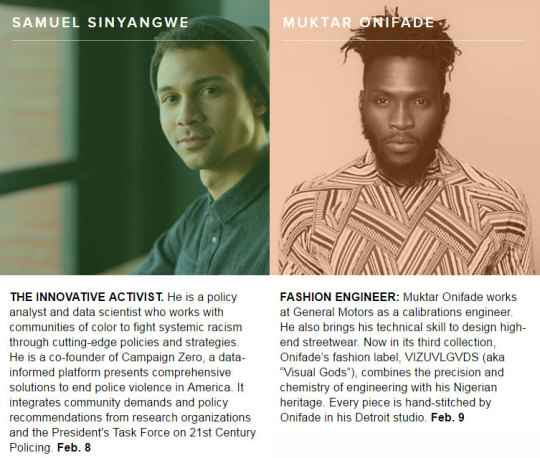



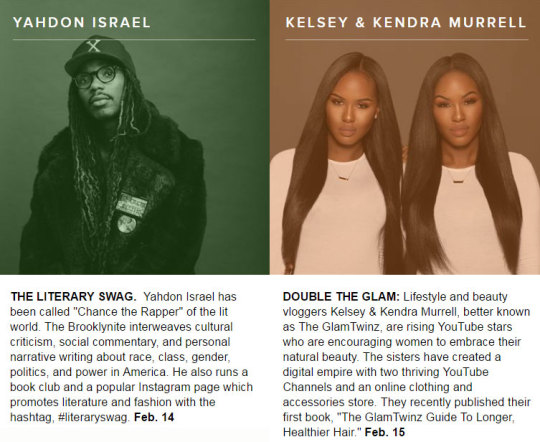




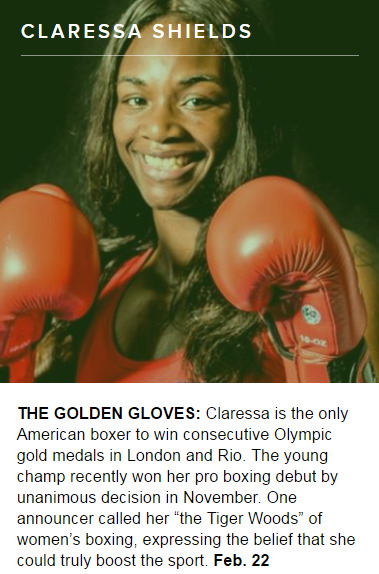
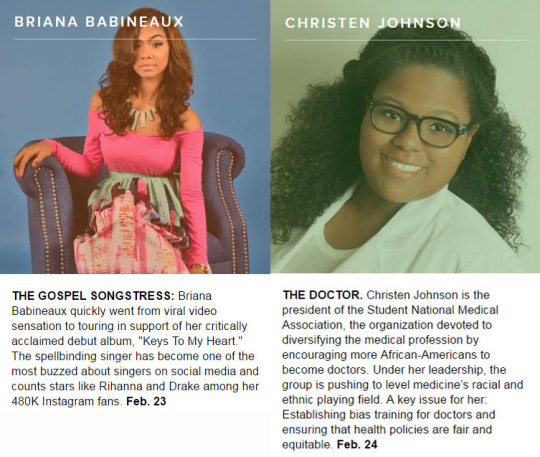


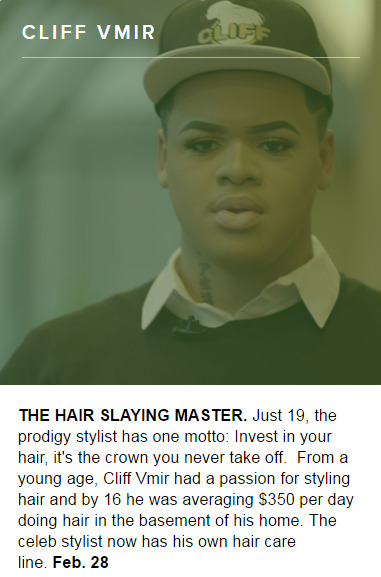
These Black men and women make history today. They remind everybody what it means to be young, gifted and unapologetically Black. These young Black talents faced discrimination and bullying in their way to success and now they have become an inspiration to us.
Follow their stories every day over the Black History Month.
#BlackExcellence
12K notes
·
View notes
Text
Digital Journal #5
My plan for DJP #5 is to offer you space to “think out/write out” some ideas on one of the critical thinking suggestions that your text book offers, specifically the suggestions on pages 102 and 103 (SMGuide). Most of you should have completed your field research. If you have not completed your field research this step will feel like “busy work,” not effective or affective work. “Busy work” runs counter to my intent for these digital journals. If you have not already completed your field research AND notes, please let me know this as soon as possible.
Open chapter 3 in your SM Guide now. Re-read pages 102-103. You will notice that the text suggests that you have 3 different options when exploring the “Perspective of your Profile,” by focusing on the “PLACE,” by focusing on an “ACTIVITY,” or by focusing on a “PERSON/GROUP OF PEOPLE.” For this digital journal, I would like you to explore those possibilities based upon your field research experience.
DJP #5: After writing out your field research notes as described and explained on pages 94 - 98, I would like you to consider the perspective through which you will describe your subject, through PLACE, ACTIVITY, or through the PEOPLE or a PERSON.
Brainstorm a bit about which is right for your essay. Which did you intend before you walked into the event, interview, etc. This could be different now that you have experienced that interview, activity, etc.
Record that brainstorming in some way. (If this direction is confusing to you - see directions for DJP #4.)
Explore in at least 1 long paragraph which perspective you will use. Why?
Post by class time on Thursday, February 9. Remember the critical thinking you put into these brainstorming moments will make your writing infinitely stronger, more interesting, and easier to do.
0 notes
Text
Digital Journal #4
As you all prepare to attend the event, participate in the activity, or interview the person or persons you have chosen to write about in your Profile assignments, you should also be considering how you will write this essay as well as completing some surface level research that will help you to fill in context within your essays.
As an example, look at Gabriel Thompson’s “A Gringo in the Lettuce Fields” in your SMGuide texts (pages 83-6). Thompson begins his essay with narration. The essay begins in the middle of his 3rd day working in the Yuma, Arizona sun. But, you will notice that at paragraph 4 (p.84), Thompson starts to give you his research,
Since the early 1980s, Yuma, Ariz., has been the “winter lettuce capital” of America. Each winter, when the weather turns cold in Salinas, California – the heart of the nation’s lettuce industry – temperatures in sunny Yuma are still in the 70s and 80s. At the height of Yuma’s growing season, the fields surrounding the city produce virtually all of the iceberg lettuce in the United States and Canada. (p 84)
In paragraph 5, Thompson goes on to describe the history and structure of the lettuce industry. This is all information he researched outside of his experience working in the lettuce fields. You should be doing the same work as you prepare to meet with your interviewees or attend events. Your learning, brainstorming, and research should be in process and should be rigorous.
DJP #4
For this digital journal post you will work through some of that brainstorming and preparation on your digital journals. This post is due before class begins on Tuesday, February 7.
Explore whether or not you will write your essay from the spectator perspective or from the participant perspective (see p 64 of SMGuide). Why?
Your post should include extensive consideration. At least 3 paragraphs of free writing (no one cares about your grammar - this is brainstorming).
If you brainstorm better in drawings, in mind maps, or in speech, you can create your journal posts this way. Notice that tumblr will let you post audio, video, photographs, etc. We all think and process in our own unique modes. If you have not tried talking into, let’s say, a recording app on your smartphone or an ipad, you might try it and see where this takes you in your idea development. Post that. I had a student in the spring semester who enjoyed creating her posts through video. She would prepare an outline, respond to the prompt, and post her videos. Whatever aids your thinking process is great. Just don;t forget to check all of the boxes of requirements.
If you post a drawing, take a picture of it and post that. Be certain though that I can see it clearly or I will not be able to respond or give you full credit for it.
Your post should include some sort of beginning research on your chosen subject. What do you know? What do you want to know?
Remember, post before class on Tuesday to receive full credit.
0 notes
Link
0 notes
Text
Week 3: DJP #3
In your readings this week, you are being introduced to the process of writing within the constructs and designs of the profile. As suggested in your SMGuide reading, we write profiles for many different reasons. Profiles can inform others of need, can celebrate community projects, can highlight the accomplishments of a person making a difference in some way. These are just a few examples.
In your reading “Transcending Polarization: Beyond Binary Thinking,” Jack Denfeld Wood and Gianpiero Petriglieri, you read about dualism, binary thinking, polarization, and groupthink. Wood and Petrilieri write,
Whether we consider physiology and psychology of individual decision making or the pattern of group and collective decision making, the process begins with a tendency toward binary thinking and polarization. (38)
Our theme this semester is BREAKING BINARIES. We will begin that work by considering this discussion offered both by Wood and Petriglieri and in the film we watched, What the Bleep Do We Know?, about our instinctual habit toward either/or arguments.
For DJP #3, I ask you to consider the documentary, What the Bleep Do We Know?, in connection with what Wood and Petriglieri are offering about our proclivity to binary thinking. Was there something specific that struck you from the documentary (look back at your notes) that further illustrates and supports Wood and Petriglieri’s discussion?
Describe the moment or section of the documentary you are considering. Describe it as you would if you were explaining it to someone who has not watched the film.
Explain how this connects to the quote from your readings (above).
Write at least 2 paragraphs, more is fine. Your blog will hold lots of information - write as much as you feel.
This DJP is due Thursday morning by 11:00 AM, (February 2).
0 notes